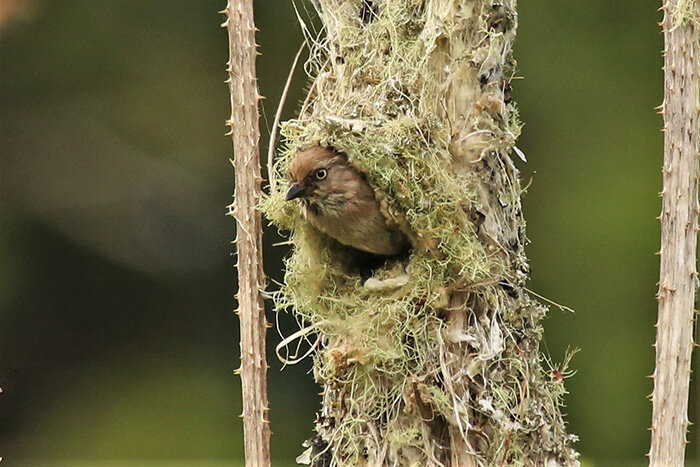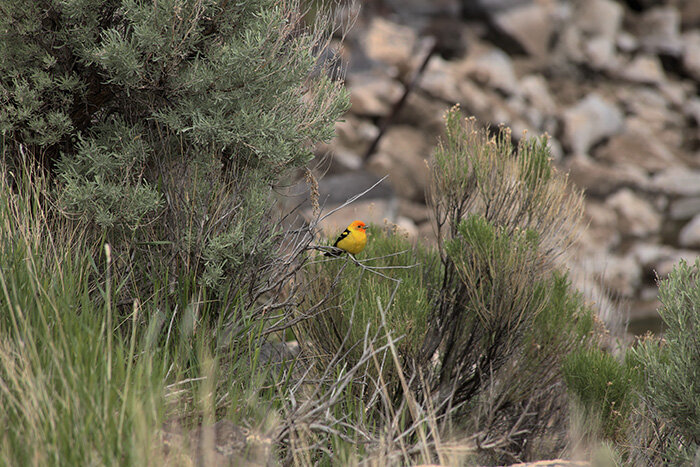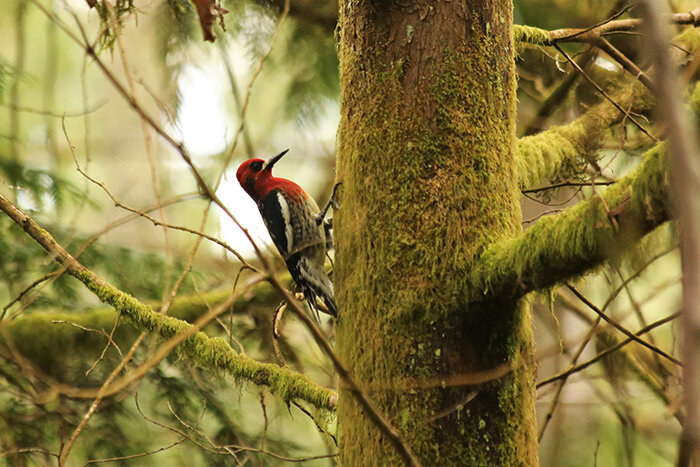 Adult Female Bushtit leaving a nest.
Adult Female Bushtit leaving a nest.I hate my alarm.
It’s set to my favorite song of all time, Rusted Root’s "Send Me On My Way." Yet that only slightly numbs the aching feeling of waking up at this hour. The sun will peek over the horizon in half an hour, and only then will the clock read 5:15 a.m.
I consider throwing myself back under the covers. But then think about what lies just outside my door. I slip on some oversized sandals, throw one too many Clif Bars into my pack, and barely remember to fill my water bottle. Lastly, I grab the tattered and broken strap holding up my binoculars, and with a gentle maneuver, throw them around my neck.
I’m going birding.
The woods of Galbraith Mountain are just a short walk from my house. To wake my body up, I start to shuffle up the residential street. Quickening to a pace that hurts my newly awakened bones, I begin to open my ears. When I hit the trailhead and hear the crunch of needles and dirt beneath me, I stop and listen. The first birds of the day are heard rather than seen.
The distant staccato and rising song of the Pacific-slope flycatcher comes to my attention. It's the breeding season here, so the birds sing and call to either attract a mate or keep others away.
 Adult Male Western Tanager in eastern Washington.
Adult Male Western Tanager in eastern Washington.Listening to the woods fill with noise feels like an orchestra rehearsal. Everyone playing their parts, and in time, coming together in a synchronous and harmonious manner. I'm here to piece together the players of that orchestra, and if I'm lucky, get to watch them in action. I'm the only one here, and I feel fortunate to be sharing this mountain with the wildlife that lives here.
Light is beginning to creep through the mossy limbs of monstrous Douglas firs. Around my neck, my binoculars remain armed for the faintest flash of movement. A small silhouette flies overhead. Desperately, I try to find the bird in my binoculars, but it was too fast; it’s gone. I settle down and look around me. A Pacific wren, a chunky, small, brown bird, belts out a robust song. I see it standing on top of a fern with its head and tail cocked up to the sky. One of the smallest birds in these woods, its song resonates throughout the landscape unlike any other. I watch the little wren for some time and then head further down the trail.
The soundscape is starting to come alive now. Warbling vireos sing from the maples, Swainson's and varied thrushes harmonize eerie yet beautiful tunes, and Wilson's warblers display their bravado from the ground story.
The trail is lined with delightful morning snacks, and I am happy to indulge. Huckleberry, salmonberry, thimbleberry and blackberry all beg to be eaten as I hike. As I reach into one blackberry bush, I startle something nearby.
A striking combination of orange and black darts past me and lands in a nearby cedar. I stare at it, in love with the plumage this bird has evolved. I notice red stains all over its bill that give it a momentarily gruesome look. I see the elderberry bush it flew out of and giggle. I feel bad for disturbing its early meal, so I take a few steps back and watch. This is a male black-headed grosbeak. This species looks exceptionally beautiful in this region. It relieves the continuous dark greens and yellows of the canopy, and browns of the forest floor. It stands out like few others do, and I revel in its ability to distract me. Like many other birds here, black-headed grosbeaks are only part-time residents. Soon, they will embark on a journey through the U.S. and into lands richer in food such as Mexico, Central or South America. Stepping into a clearing, large trees scatter the ground and the smell of freshly cut wood envelopes me.
 Adult Red-breasted Sapsucker scaling a western redcedar.
Adult Red-breasted Sapsucker scaling a western redcedar.A high-pitched, watery and rising call note floats past overhead. I look up and see the dark outline of a single bird flying over. I recognize the call as that of a brown-headed cowbird. One of the more unique species to be found here, they are brood parasites, meaning they lay eggs in the nests of other species. Passing off parental duties in the hope that the parents of the chosen nest are welcoming to the imposters. My eyes are still straining to watch the cowbird when a dark shape shoots into the clear sky and flies in tight circles overhead. The wingbeats are rapid and its wings are long, yet the body is small and round.
A couple of Vaux’s swifts have decided to forage above the clearing. Astonishing birds, this species champion the skies. Darting, jetting, twisting, propelling itself in a myriad of directions at seemingly the same time. Swifts are so adept and tied to flight that they are known to sleep while flying during migration. Leaving the clearing, darkness swallows me as the giant evergreens tower overhead.
My legs sting and I crave something other than chocolate chip granola bars. Yet, something about me feels so much better. As I turn the bend toward home, a mirage of shimmering black and yellow emerges; evening grosbeaks. Not soon after, a bald eagle cries out from a nest, and I feel as if I should stay out another few hours.
Which I just might do. x
Ben Stalheim is a wildlife biologist from Bellingham, Washington. He travels the country to study the birdlife of the United States and explore new places.